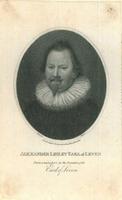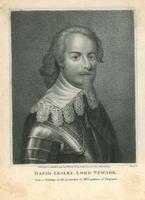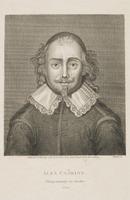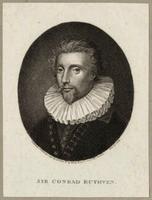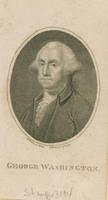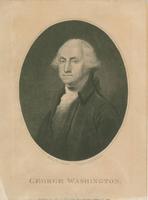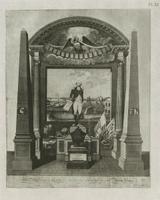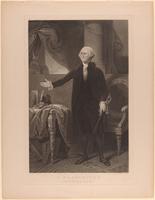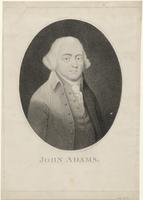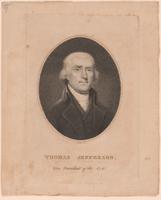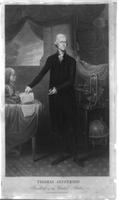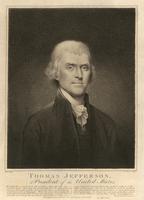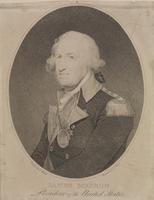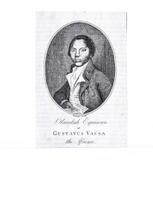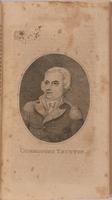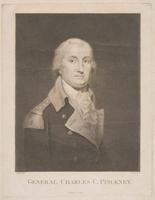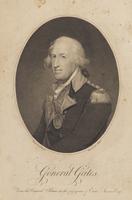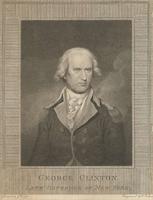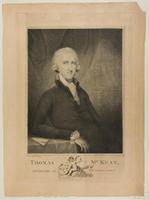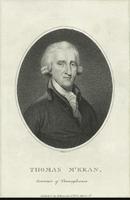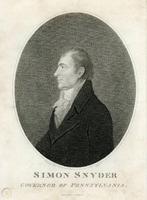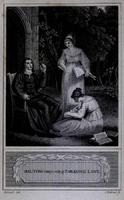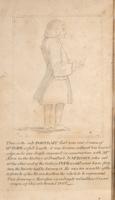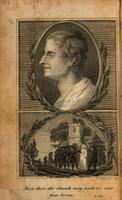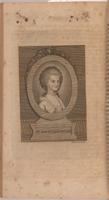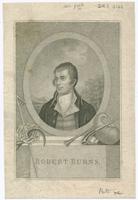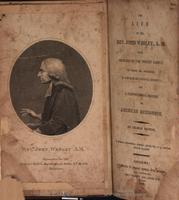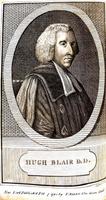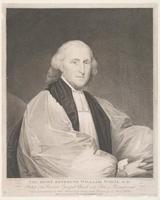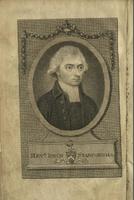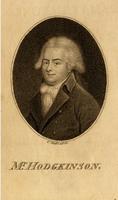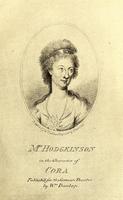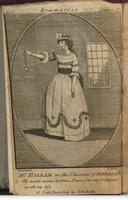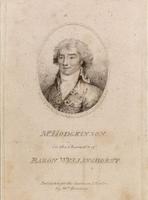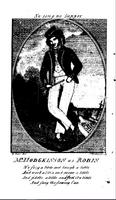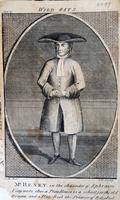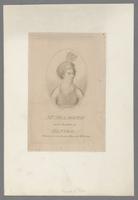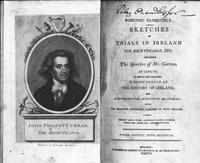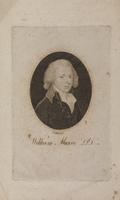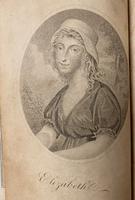Part 3. Portraits
There are more than 30 known portraits by Cornelius Tiebout, including four of George Washington, three of Thomas Jefferson, and one portrait that was used for two different men— regarding this anomaly, see the paragraph below for Horatio Gates. Tiebout's earliest portraits were stipple-engraved in London, beginning with his portrait of John Jay.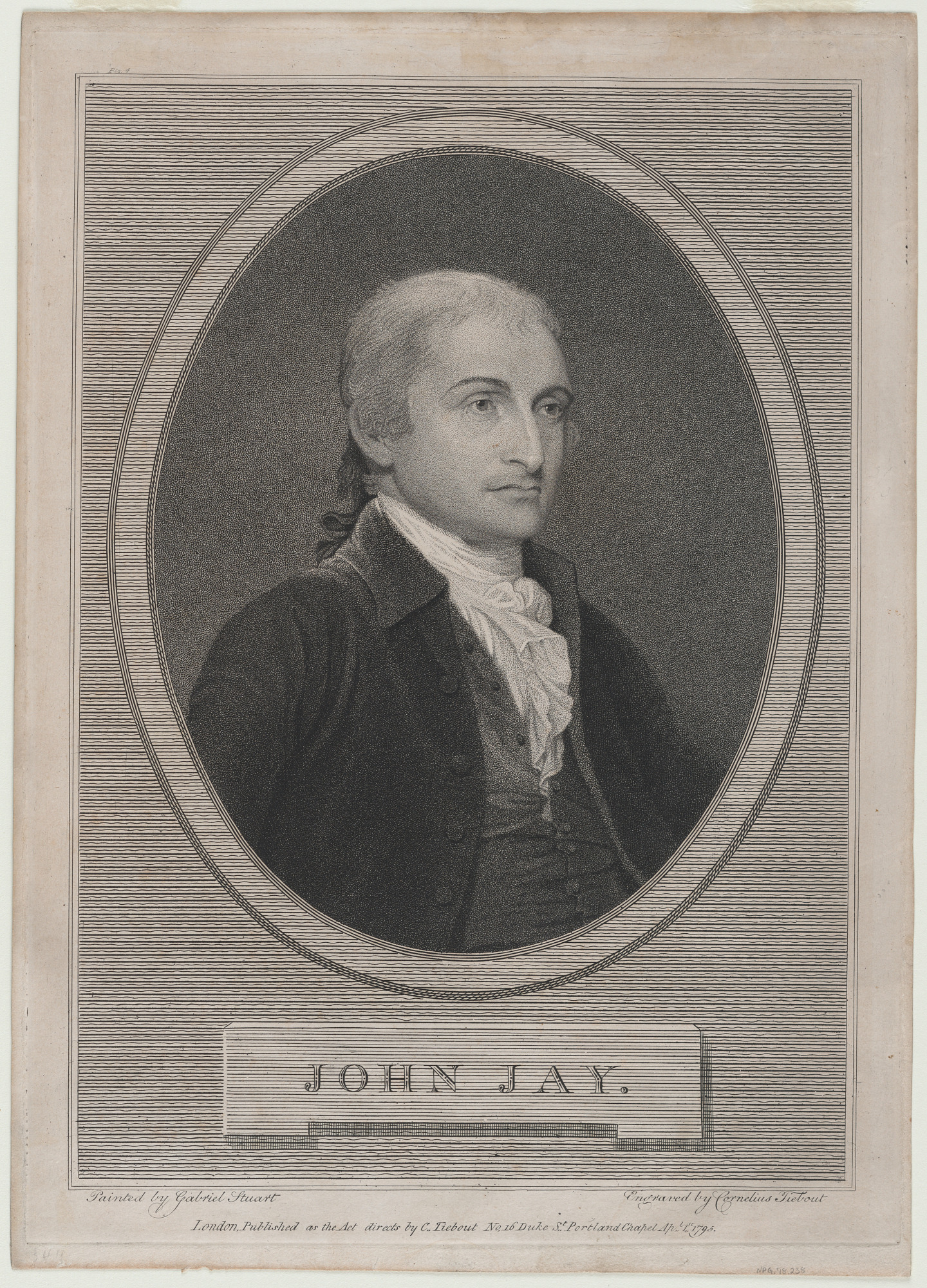
3.1 Portraits Published in London, 1794-1796
As noted in the Introduction, many of Tiebout's engravings were assigned Stauffer numbers, which, for four of the five Tiebout portraits published in London during Tiebout's residence there (1793-1796), are as follows: Jay, 3179; Alexander Lesley, 3183; David Lesley, 3184, and Erskine, 3170. The engraving of Sir Conrad Ruthven was not indexed by Stauffer or Fielding.
John Jay (1745-1829), first Chief Justice of the United States (1789-1795), and then governor of New York (1795-1801). Like Tiebout, Jay, on his mother's side, was of French Huguenot and Dutch descent. Stauffer (vol. 1, p. 271) writes that "In April, 1796, Tiebout published in London his quarto portrait of John Jay. This is probably the first really good portrait engraved by an American-born professional engraver." Stauffer (vol. 2, p. 523) describes the portrait as a stipple engraving of dimensions 12.5x8.11 (i.e., 12 and 15/16 by 8 and 11/16, square inches), after Gabriel Stuart, London, Published as the Act directs by C. Tiebout, No. 16 Duke Street Portland Chapel, April 1, 1795. (It appears that the year of publication was verily 1795, not 1796 as in the quotation above.) The addresses that appear with the other London engravings perhaps indicate where they could be purchased, rather than Tiebout's place of residence—which was in the house of the artist Benjamin West. For an image of Jay in West's painting of the signing of the Treaty of Paris, see John Jay. For information about the John Jay College of Criminal Justice, see History.
Although the name Gabriel Stuart appears on Tiebout's engraving of John Jay and others, it is certain that "Gabriel Stuart" was actually the well-known American artist, Gilbert Stuart. This artist went to London several times, and it appears likely—as there are several other works signed "Gabriel" that are known to be by Gilbert—that Gilbert did in fact sometimes use the name Gabriel. See, for example, Curator's comment, British Museum and an attribution to both Gabriel and Gilbert, Library of Congress. This double usage explains the following notice from The Argus, 27 July 1795:
Cornelius Tiebout.—Proposals. By Cornelius and Alexander Tiebout, to publish by subscription, Two Portraits, George Clinton and John Jay. Engraved by Cornelius Tiebout, Citizen of New York, now resident in London. Taken from original paintings of our celebrated countrymen, Gabriel Stewart and the Late Joseph Wright [1756-1793, another American artist who trained in London].For a study of Stuart and other American artists with experience in London, see Jessica Wirgau, ' "To Counterfeit the Soul": Portraiture at Historic Smithfield', The Smithfield Review XI (2007) 29-49. Pages 40-45 include a section on "Gilbert Stuart and American Portraiture". Although the name "Gabriel Stuart" is missing, Wirgau notes that "Stuart had met and painted Jay while in London and came to New York to paint him once again in the spring of 1794. Jay introduced Start to many of this New York patrons and wrote a letter of introduction for Stuart to President Washington in Philadelphia. With this letter in hand and a list of thirty-two patrons who had commissioned a total of thirty-nine portraits of the president, the artist moved to Philadelphia in November 1794 with the goal of securing a sitting with Washington straight away".The size of each print to be 10 by 13 inches printed on excellent paper. Price one dollar and an half, to subscribers; one third to be paid at the time of subscribing, and the remainder on delivery of the prints. Those who wish, may subscribe for either of the Portraits separate....
Gilbert Stuart's painting of John Jay, the basis for Cornelius Tiebout's engraving, can be viewed here: National Portrait Gallery
***************************
In London, in 1796, the following book was printed for John Herbert: Iconographia Scotia, of Portraits of Illustrious Persons of Scotland Engraved. Tiebout's engravings of Erskine and Ruthven are included, and although the engravings and Alexander Lesley and David Lesley—who were both illustrious persons of Scotland—are not in the book, they were published by Isaac Herbert (seller of books and prints, perhaps related to John Herbert), with address 29 Great Russell Street, Bloomsbury (London). Details are given below.
Alexander Leslie, [First] Earl of Leven (1580-1661), Scottish soldier in Swedish and Scottish service. The surname is sometimes spelled L-e-s-l-e-y. This small engraving, after artist C. Jansen, was published by Isaac Herbert, 1 September 1795.
David Lesley, Lord Newark (1600-1682), 1st Lord Newark, Scottish soldier in Swedish, Scottish, and Russian service. The surname is sometimes spelled L-e-s-l-i-e. This small engraving, after an unidentified artist, was published by Isaac Herbert, 12 September 1795.
Alexander Erskine (1598-1656), born in Scotland, plenipotentiary for Sweden at the Treaty of Munster, 1648. This small engraving, after an unidentified artist, was published by Isaac Herbert, 28 February 1796. Elsewhere, the surname is spelled E-r-s-k-e-i-n; as in Meisterdrucke.
Sir Conrad Ruthven, a Scottish gentleman, was probably alive in 1650.
3.2 Presidents
George Washington (1732-1799) was the Commander-in-Chief of the Continental Army in the American Revolutionary War, and he was the first President of the United States. The four known Tiebout engravings of Washington, all stipple, indexed by Stauffer as 3194 to 3197, are shown in that order below. The first, (Stauffer 3194), after Gilbert Stuart is the frontispiece of "Elogium on General Washington: Two Discourses..." (see image below), dated 1800. The second (Stauffer 3195), also after Stuart, was published on 8 January 1800 by Tiebout, with address 28 Gold Street, New York. The third (Stauffer 3196), after Charles Buxton, was published by Charles Smith, New York, 1798. Done in both line and stipple, it is one of Tiebout's largest engravings: 25.2 x 21.9 (i.e., 25 + 2/16 by 21 + 9/16 square inches). The fourth (Stauffer 3197) is after Stuart's Landown portrait of Washington. It also was published by Tiebout, with address 83 Chesnut Street, Philadelphia, dated 1801. (C-h-e-s-n-u-t was a common alternate spelling for C-h-e-s-t-n-u-t.) Stauffer mentions not only the first state of this engraving, as described here, but also second and third states, published by others. (A state of an engraving is a previously used plate that has been refurbished, with possible minor changes.) The four engravings are included in the print collection in the museum at Mount Vernon, Washington's home.John Adams (1735-1826), second President of the United States, 1797-1801. This engraving is after William Joseph Williams.
Thomas Jefferson (1743-1826), third President of the United States, 1801-1809. Tiebout's earliest engraving of Jefferson was published by David Kennedy, No. 228, Market Street, Philadelphia, in 1797. In its first state, the inscription includes "Vice President of the U.S." These words are not included in second state, which appears as frontispiece in The Literary Magazine and American Register, vol. 2, published in Philadelphia in 1804, while Jefferson was no longer Vice President. This engraving is Stauffer 3180. Stauffer 3181 was published by Mathew Carey, 118 Market Street, 20 February 1801; two later states are known. Stauffer 3182, after Rembrandt Peale, was published by Augustus Day, 38 Chesnut Street, Philadelphia, probably in 1801; two later states are known.
James Monroe (1758-1831), fifth President of the United States, 1817-1825. This is state 2 of the engraving of Horatio Gates (see below).
3.3 Olaudah Equiano
An important and distinctive literary publication in late eightennth-century England was The Interesting Narrative of the Life of Olaudah Equiano, or Gustavus Vassa, the African. As Akito Ito writes in Early American Literature 32 (1997) 82-101, "Equiano published the Narrative in 1789, long after he had bought his freedom in 1766 and become involved with the abolitionist movement in England." In 1791, the American edition of the Narrative was published in New York. Tiebout was the engraver of the portrait of Equiano. His engraving was based on the portrait in the English publication (of which there were eventually eight editions). Among subscribers (viz., supporters) for the American edition were Tiebout and his brother Alexander. See Angelo Costanzo, Surprising Narrative: Olaudah Equiano and the Beginnings of Black Autobiography New York, Greenwood, 1987, and Susan M. Marren, "Between Slavery and Freedom: The Transgressive Self in Olaudah Equiano's Autobiography," PMLA 108 (1993) 94-105. Online references include a description of Tiebout's engraving and the Wikipedia article on Equiano.3.4 Charlotte Temple
Charlotte Temple is a fictional character in one of the best-selling novels of early nineteenth-century England and America. As already noted in the Introduction, Matthew Pethers's article explores the cultural significance of the novel in general and, especially, Tiebout's engraving of Charlotte Temple. Pethers also compares this engraving with Tiebout's engravings of Olaudah Equiano and Ann Eliza Bleecker. See the Wikipedia article on Charlotte Temple and the note below for Elizabeth.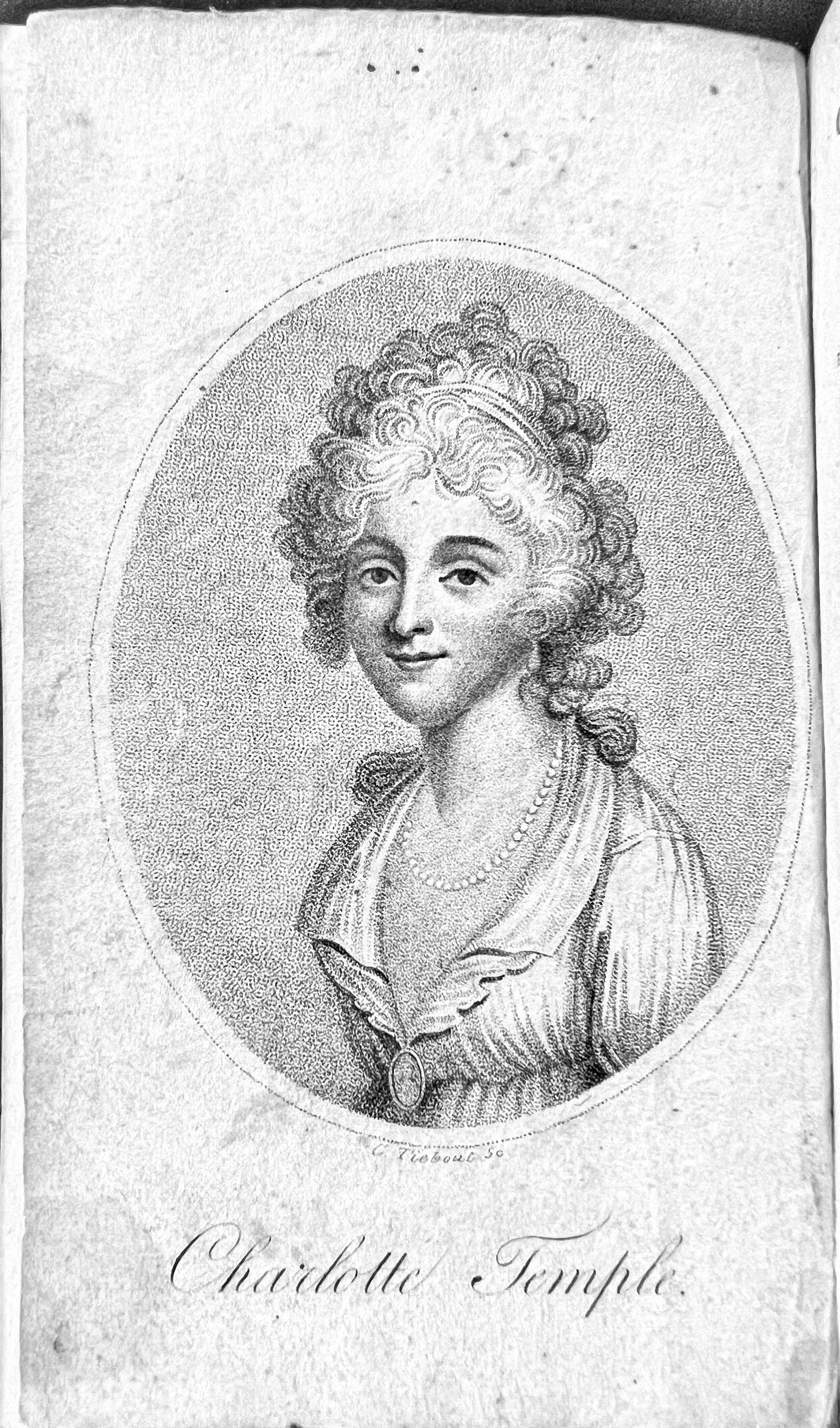
was he the artist, as well as engraver?
Image AC7 R7997 791c 1809, Houghton Library,
Harvard University
3.5 Military Leaders
Commodore Truxton (1755-1822) was commander of the ships USS Constitution and USS President. Related websites: Wikipedia article, Truxton Naval Medal, USS Truxton.General Charles Cotesworth Pinckney (1746-1825), United States Minister of Finance, Office in the Continental Army during the Revolutionary War. See Wikipedia article. The engraving is after Jeremiah Paul.
General Horatio Gates (1727-1806), Controversial British-born officer in the Continental Army during the Revolutionary War. The engraving was published by C. & A. Tiebout [Cornelius and his brother Alexander], 1 January 1798. The image shown below is the 1st state. Mysteriously, the 2nd state was obtained from the first by changing the title to "James Monroe, President of the United States." However, the image is after Gates, as can be verified by comparing the image to Gilbert Stuart's painting of Horatio Gates:. See also the Wikipedia article.
3.6 Governors
For biographical sketches, portraits, and contexts see Pennsylvania Governors and New York Governors.Thomas McKean (1734-1817) was the second governor of Pennsylvania (1799-1808) and the Chief Justice of Pennsylvania (1777-1799). During the American Revolution, McKean was a delegate to the Continental Congress. He was a signer of the Declaration of Independence. See the Wikipedia article.
Thomas McKean, another Tiebout engraving of McKean.
Simon Snyder (1759-1819) was the third governor of Pennsylvania (1808-1817). See the Wikipedia article.
George Clinton (1739-1812) was the first governor of New York and fourth vice president of the United States. See Wikipedia.
3.7 Poets
John Milton (1688-1744), with daughters Mary and Deborah. The daughters are identified at Sir John Soane's Museum Collection Online. See Wikipedia.Alexander Pope (1688-1744) is regarded as one of the foremost English poets of the early 18th century. See Wikipedia.
Thomas Gray (1716-1771) was a British poet and professor of modern languages and history at Cambridge University. Appearing below is Tiebout's engraving of Gray, the frontispiece of The Poetical Works of Thomas Gray, published in Philadelphia for Benjamin Johnson, Jacob Johnson, and Robert Johnson, 1804.
Ann Eliza Bleecker (1752-1783) was an American writer of pastoral poems and the novel The History of Maria Kittle, which may have been the earliest fictional account of American Indians. Her daughter, Margaretta V. Bleecker Faugéres, also a poet, published The Posthumouos Works of Ann Eliza Bleecker. See Ann Eliza Bleecker and Margaretta V. Bleecker Faugé res.
Robert Burns (1759-1796), Scottish poet, author of "Auld Lang Syne". See Robert Burns and Auld Lang Syne.
3.8 Religious Leaders
John Wesley (1703-1791) together with his brother Charles Wesley (1707-1788), were priests in the Church of England who became the founders of the Methodist denomination. See Wikipedia. Tiebout's engraving of Wesley is after a portrait by Henry Edridge (1769-1821). The portrait, dated 1790, is preserved in the Wesleyana Collection, Pitts Theology Library, Emory University.Hugh Blair (1718-1800) was a Scottish minister, regarded as one of the earliest eminent theorists of written discourse. Tiebout's engraving of Blair is the frontispiece of Blair's Sermons, published 7 February 1793 by T. Allen, No. 12 Queen Street, New York. The engraving is not included in the 1792 printing by T. Allen, catalogued as the 2nd American edition, from the 17th London edition. The image of this rare portrait was provided by the Harvard Divinity School.
The Right Rev. William White (1748-1836) was the first and fourth Presiding Bishop of the Episcopal Church of the United States (1789 and 1795-1836). He was consecrated as bishop at Lamberth Palace Chapel in London by John Moore, the Archbishop of Canterbury (and three other bishops in the Church of England) in 1787. Having served as Chaplain of the Continental Congress (1777-1789), he played a major role in the establishment of the Episcopal Church as a successor to the colonial Anglican Church (i.e., Church of England, before the American Revolution). See William White (bishop of Pennsylvania).
John Stanford (1750-1817). Cornelius Tiebout's engraving of John Stanford, after William Franks, is the frontispiece of Stanford's The Christian's Pocket Library, published by T. & J Swords, New York, 1796. See Rev. Stanford, First New York and United States Prison Chaplain.
3.9 Actors and Actresses
John Hodgkinson (1766-1805) was a New York actor, born in England; see Wikipedia.Mrs. John Hodgkinson (1771-1803), full name: Frances Brett Hodgkinson. She was a New York actress, born in England. See Wikipedia and Part 18.
Mrs. Hallam (? - 1817?), full name: Mrs. Lewis Hallam, Jr. Before marriage, she was Eliza Tuke. See Part 18.
John Hodgkinson as Baron Wellinghorst. See Part 18.
John Hodgkinson as Robin. See Part 18.
John Henry as Ephraim. See Part 18.
Mrs. Melmoth (1749? - 1823), full name: Charlotte Melmoth. Born in England, she became one of the best-known actresses in the New York theatre during 1793-1805. See Wikipedia and Part 18.
3.10 Others
John Philpot Curran (1750-1817) was an Irish orator, politician, and lawyer. See Wikipedia.William Fordyce Mavor (1758-1837) was a Scottish writer, teacher, and priest. Among his many publications is General Collection of Voyages and Travels, 28 volumes, London, 1810. See Part 7 and William Fordyce Mavor.
Elizabeth is a fictional character in Elizabeth; or, the Exiles of Siberia, by Sophie Ristaud Cottin. The book was first published in Paris with the title Élisabeth ou les Exilés de Sibérie. Cornelius Tiebout engraved the image of Elizabeth for the frontispiece of Mathew Carey's publication of the book in 1809. As in the engraving of Charlotte Temple for the same publisher and year of publication, it appears possible that Tiebout was not only the engraver—of both Charlotte and Elizabeth;—but also the artist.


